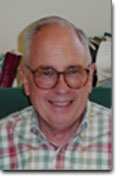Edward M. (Ted) Eyring
 PHYSICAL & ANALYTICAL CHEMISTRY
PHYSICAL & ANALYTICAL CHEMISTRY
Professor
B.A., 1955
Ph.D., 1960, University of Utah
NSF Postdoctoral Fellow, University of Goettingen, 1960
Phone: (801) 581-8658
Office: 2428 HEB-S
Email: eyring@chem.utah.edu
Activities & Awards
- ACS Utah Award, 1976
- NATO Senior Fellowship, 1977
- Dept of the Army Outstanding Civilian Service Medal, 1977
- Indo-American Fellowship, 1978
- J.S. Guggenheim Fellow, 1982
- University Distinguished Research Award, 1991
- Willard Gardner Prize of the Utah Academy of Sciences,
Arts and Letters, 1993 - ASUU Student Choice Award for Excellence in Teaching, 1997
- Robert W. Parry Teaching Award, 1998
- Fellow in The American Association for the Advancement, 2011
- Utah Governor’s Medal for Science and Technology, 2011
Research Interests
Ted Eyring and his co-workers make and use metal nanoparticles in the 2 nm to about 60 nm diameter range. In one project, nanoparticles of silver metal are incorporated ino the pores of a naturally occuring zeolite calledchabazite. The resulting material is a very effective trap for capturing xenon gas molecules present in truly trace amounts in air. This phenomenon has a potential practical application in a hospital operating amphitheater where it would be advantageous to recicle xenon which is an especially effective but expensive anesthetic. How silver metal nanoparticles capture xenon was addressed by a computational chemistry graduate student, Hoa Nguyen, in a paper published jointly with Truong group. The capture of other permanent gases from complex gas mixtures continues to be a well funded experimental gas chromatography/materials project in the Eyring group.
IN a joint project with the Ernst and Pugmire research labs, iron, cobalt and ruthenium nanoparticles hosted by xerogels catalyze the synthesis of jet fuel from syngas. The Fischer-Tropsch chemistry dating back to the 1920's yields occasional surprises when students carrying out the experiments use their ingenuity in preparing mixed metal heterogeneous catalysts. Experimental tools used to characterize these catalysts include temperature programmed reduction (TPR), Brunauer, Emmett and Teller (BET) surface area measurements, transmission electron microscopy (TEM), powder pattern X-ray diffraction (XRD), X-ray absorption near edge structure (XANES) measurements, and near edge X-ray absorption fine structure (EXAFS) measurements. (These last two experiments are carried out by collaborators at a synchrotron at Brookhaven National Laboratory).
Another project that the Eyring group is working on, in collaboration with Chemical Engineering colleagues, is Chemical Looping Combustion (CLC). In CLC a fluidized bed fuel reactor and a fluidized bed “air” reactor are operated in a closed loop arrangement. Air and fuel never come in direct contact with one another. Instead air oxygen is transferred to a reduced metal in the “air” reactor symbolized by the following stoichiometric equation:
O2 + 2 MexOy–1-> 2 MexOy
The reaction takes place at a high temperature of 800 to 1000ºC. The fluidized bed “air” reactor carries the metal oxide (called the “oxygen carrier”) into the fluidized bed fuel reactor into which a fuel such as syngas or powdered coal is fed. The reaction:
CnHm + (2n + ½ m)MexOy-> n CO2 + 0.5m H2O + (2n + ½ m)MexOy–1
takes place, and the heat normally released by combustion of the fuel is released in this flameless combustion process. The flue gas emerging from the fuel reactor contains primarily CO2 and steam. The steam can be removed by condensation, and the CO2 can be sequestered, thereby avoiding its release into the atmosphere. THis scheme for preventing release of CO2(g) into the atmosphere was invented by two engineers at MIT many years ago but has regained currency because of growing concern for "global warming".
Selected Publications
- Huggins, F. E.; Bali, S.; Huffman, G. P.; Eyring, E. M. Iron-oxide aerogel and xerogel catalyst formulations: Characterization by 57Fe Moessbauer and XAFS spectroscopies. Spectrochimica Acta, Part A: Molecular and Biomolecular Spectroscopy 2010, 76A, 74-83.
- Masiker, M. C.; Mayne, C. L.; Boone, B. J.; Orendt, A. M.; Eyring, E. M. 7Li NMR chemical shift titration and theoretical DFT calculation studies: solvent and anion effects on second-order complexation of 12-crown-4 and 1-aza-12-crown-4 with Lithium cation in several aprotic solvents. Magnetic Resonance in Chemistry2010, 48, 94-100.
- Bali, S.; Huggins, F. E.; Ernst, R. D.; Pugmire, R. J.; Huffman, G. P.; Eyring, E. M. Iron-Ceria Aerogels Doped with Palladium as Water-Gas Shift Catalysts for the Production of Hydrogen. Industrial & Engineering Chemistry Research 2010, 49, 1652-1657.
